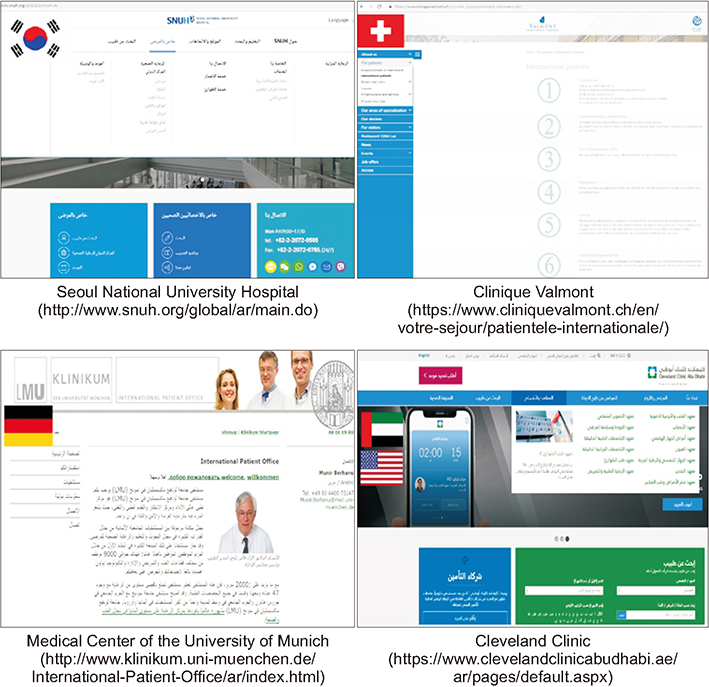Healthc Inform Res.
2019 Jan;25(1):33-40. 10.4258/hir.2019.25.1.33.
Analysis of Interactive E-Health Tools on United Arab Emirates Patient Visited Hospital Websites
- Affiliations
-
- 1College of Nursing, Seoul National University, Seoul, Korea. kim0424@snu.ac.kr
- 2Research Institute of Nursing Science, Seoul National University, Seoul, Korea.
- KMID: 2434534
- DOI: http://doi.org/10.4258/hir.2019.25.1.33
Abstract
OBJECTIVES
This study is to scrutinize the website of Seoul National University Hospital in Korea, Clinique Valmont in Switzerland, Medical Center of the University of Munich in Germany, Cleveland Clinic Abu Dhabi in the United Arab Emirates (UAE) to suggest successful communication factors to the medical service providers who deal with Middle Eastern patients.
METHODS
Using content analysis and in-depth interviews, this research examines four hospitals commonly visited by Middle East patients. The four hospitals approaches to implementing interactive e-health tools on their web sites are reviewed. Four hospitals selection criterion was process by focus group interview of government officials in UAE health sectors.
RESULTS
The way of providing medical information differed by hospitals that used e-health tools. The analysis of each website shows a different way providing medical information, services and education. There are important differences among hospitals. These include decision-making, planning processes and outcomes of implementing e-health tools online, as well as potential obstacles to such implementation. Thus, hospitals can learn and design effective interactive tools by applying e-health tools on their websites.
CONCLUSIONS
Each website showed different interactive tools such as traditional functional tools, core e-business tools, patient support tools, visitor related tools, emerging functional tools. By applying the interactive e-health tools sets an objective view for e-health strategy and vision for the hospitals conveying information through the website. According to the type of hospitals and its location different methods of strategy should be applied. Targeting not only the patients but also the general website users will eventually improve health information accessibility.
Keyword
MeSH Terms
Figure
Reference
-
1. Zein NN. Seeking medical care abroad: a challenge to empathy. Cleve Clin J Med. 2016; 83(11):801–803.
Article2. Mukherjee A, McGinnis J. E-healthcare: an analysis of key themes in research. Int J Pharm Healthc Mark. 2007; 1(4):349–363.
Article3. Reid P, Borycki EM. Emergence of a new consumer health informatics framework: introducing the healthcare organization. Stud Health Technol Inform. 2011; 164:353–357.4. Gallant L, Irizarry C, Kreps GL. User-centric hospital web sites: a case for trust and personalization. e-Service J. 2006; 5(2):5–26.
Article5. Hong YJ. A study on Middle Eastern patients' satisfaction with services and revisit decisions [master's thesis]. Seoul, Korea: Seoul National University;2017.6. Huang E, Chang CC. Patient-oriented interactive E-health tools on U.S. hospital Web sites. Health Mark Q. 2012; 29(4):329–345.7. Huang E, Chang CC. Case studies of implementation of interactive e-health tools on hospital Web sites. e-Service J. 2014; 9(2):46–61.
Article8. Seoul National University Hospital [Internet]. Seoul, Korea: Seoul National University;c2019. cited at 2019 Jan 10. Available from: http://www.snuh.org/global/en/main.do.9. Clinique Valmont [Internet]. Montreux, Switzerland: Clinique Valmont;c2019. cited at 2019 Jan 10. Available from: https://www.cliniquevalmont.ch/en/.10. Medical Center of the University of Munich [Internet]. Munich, Germany: Medical Center of the University of Munich;c2019. cited at 2019 Jan 10. Available from: http://www.klinikum.uni-muenchen.de/International-Patient-Office/en/index.html.11. Cleveland Clinic Abu Dhabi [Internet]. Abu Dhabi, UAE: Cleveland Clinic Abu Dhabi;c2019. cited at 2019 Jan 10. Available from:https://www.clevelandclinicabudhabi.ae/en/patients-and-visitors/pages/default.aspx.12. World University Rankings [Internet]. London, UK: Times Higher Education World University Rankings;c2019. cited at 2019 Jan 10. Available from: https://www.timeshighereducation.com.13. Ornes LL, Paulson P, Snyder K. A tool to evaluate your website for patient engagement. Int J Healthc Manag. 2014; 7(2):69–74.
Article14. Huerta TR, Walker DM, Ford EW. An evaluation and ranking of children's hospital websites in the United States. J Med Internet Res. 2016; 18(8):e228.
Article15. Jeddi FR, Gilasi H, Khademi S. Evaluation models and criteria of the quality of hospital websites: a systematic review study. Electron Physician. 2017; 9(2):3786–3793.
Article
- Full Text Links
- Actions
-
Cited
- CITED
-
- Close
- Share
- Similar articles
-
- Personal, Occupational, and Public Health Perspectives on Dealing with the First Case of Influenza A (H1N1) in the United Arab Emirates
- The Co-Administration of COVID-19 and Hepatitis B Vaccines, Should Safety Be a Concern?
- Lost in Translation? Challenges and Opportunities for Raising Health and Safety Awareness among a Multinational Workforce in the United Arab Emirates
- Causes of Hospitalization in Patients With Cardiorenal Syndrome Across the Spectrum of Ejection Fraction
- The Effects of Korean Medical Service Quality and Satisfaction on Revisit Intention of the United Arab Emirates Government Sponsored Patients


